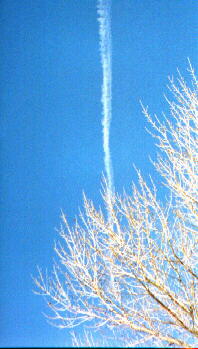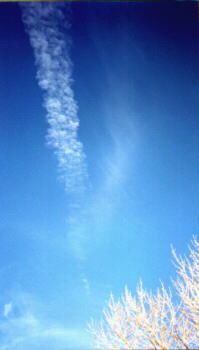|
|
|
PRELIMINARY METEOROLOGICAL STUDY :
UNNATURAL CLOUD FORMATIONS IN SANTA FE NM



February 14, 1999 Santa Fe 0930-1000
Summary: The argument given that upper atmospheric conditions in Santa Fe NM allow for persistent contrails and subsequent cloud formation is refuted with an analysis of upper altitude relative humidity data. The more plausible explanation is direct chemical spraying from aircraft active over this same area, as documented with abundant photographic evidence on www.carnicom.com.
The following preliminary meteorological study has been made on August 26, 1999:
Please note the following information from http://www.weather.unisys.com/model/details.html :
"The relative humidity field is a good predictor of cloud location and thickness.
Areas of relative humidity less than 60% generally are clear or have partly cloudy skies. Areas of 60-80% are generally
overcast or mostly cloudy. Areas greater than 80% are overcast with a high likelihood of precipitation as relative
humidity approaches 100%."
The following monthly averages of relative humidity in Santa Fe NM at 30,000 ft. above mean sea level have been
obtained from the Climate Diagnostics Center of the National Oceanic and Atmospheric Administration:
Jan 1999 38%
Feb 1999 34%
Mar 1999 33%
Apr 1999 28%
May 1999 32%
June 1999 26%
July 1999 32%
Aug 1999 33% (Aug 1-Aug 26)
The average humidity for this eight month period is 32%, with a sample standard deviation of 3.7%.
The previous relative humidity field description would lead one to conclude that Santa Fe would generally have
skies at 30,000 ft. that are often very clear. This is, in fact, the meteorological norm for Santa Fe.
Now introduce 21 days of chemtrail activity as documented on www.carnicom.com. These days represent the most obvious
and blatant examples of spraying, of which numerous cloud progression photos and telephotos of offending aircraft
have been presented. These days are:
Feb 14, 16, 17, 25, 28 (27.5, 38, 60, 50, 32.5% respectively)
Mar 2, 6, 24 (55, 48, 20%)
April 7, 11, 12, 18 (25, 35, 28, 32.5%)
May 7, 17, 28, 29 (33, 35, 42.5, 50%)
July 9, 13, 14 (35, 25, 55%)
Aug 14, 26 (21, 40%)
The average relative humidity at the same 30,000 ft. above mean sea level of these 21 days is 37.5%, with a sample
standard deviation of 11.7%. This data was also obtained from the Climate Diagnostics Center of the National Oceanic
and Atmospheric Administration. By the same reasoning, one would have expected these days to be generally clear
at that altitude, but that is not the case.
On each of these days, almost without exception, the morning sky began as clear, and as the planes progressed with
the spraying, a cirrus cloud layer was created which often transformed itself into a cirro-stratus layer. In short,
a clear day became generally cloudy or hazy.
Please also note the following expectation from http://cimss.ssec.wisc.edu/wxwise/class/contrail.html :
"How long a contrail remains intact, depends on the humidity structure and winds of the upper troposphere. If the atmosphere is near saturation, the contrail may exist for sometime. On the other hand, if the atmosphere is dry then as the contrail mixes with the environment it dissipates."
By any standards, the average relative humidity of 37.5% at 30000 ft. MSL determined on observable spray days in Santa Fe NM would be considered a dry environment, and according to the previous reference any contrails should dissipate. Instead, the evidence clearly shows that clouds have formed from these trails.
Another source is quoted on http://www.politicalwomen.com/debate.htm as stating that :
"If a contrail is formed in air of low humidity, the ice crystals will rapidly
evaporate. But if the air is saturated
(humid) enough, the crystals will persist for some time."
This statement reiterates for the third time the foundation that low humidity conditions are not conducive to persistent contrails, or subsequent cloud formation. Such events do occur, however, on all 21 documented spray days in Santa Fe itemized above. An average relative humidity of 37.5% is to be considered low, and therefore by all references one would expect the 'contrails' to rapidly dissipate. The photographs on this page and elsewhere on this web site provide ample evidence that this is not the case.
One should ask, why are there clouds in our skies on these days if meteorological conditions do not normally support their formation? One reasonable explanation is that there are aircraft leaving chemical trails. Photographic evidence shows cloud formations progressing in direct correlation with aircraft activity, ground sample photographs show materials that have originated from the sky during chemtrail activity, and aircraft telephotos of spray configurations have been captured. These photographs are available at www.carnicom.com.